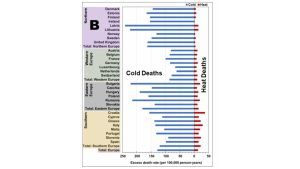The Lancet’s Scientific Chicanery on Mortality Exposed by CO2 Coalition
By Gregory Wrightstone
A deception perpetrated by The Lancet is another example of how once respected institutions of the scientific community are not above abandoning principle to advance the fearmongering of a planet warming to purportedly dangerous levels.
As reported in the CO2 Coalition’s online newsletter, The Lancet published a study showing that cold-related deaths account for 10 times the number of deaths due to heat – a comparison similar to other research findings about the relative danger of temperature extremes.
However, The Lancet pulled a sleight of hand when depicting the data in a chart to accentuate deaths due to heat and diminish those from cold.
The trickery of The Lancet’s Figure A is revealed by the CO2 Coalition’s revision in Figure B. Note that the X axis at the bottom in Figure A is in increments of 50 on the left (cold) side and in increments of 10 on the right (hot) side. This five-fold difference in scaling serves to exaggerate the number of deaths due to heat and minimize the cold-related deaths. This is technically correct, but intellectually wrong.
From The Lancet (Figure A):
From the CO2 Coalition (Figure B):

The effect of the miscalibration is readily seen by comparing the two graphs. The bars for heat deaths are much longer in Figure A than in Figure B, whose X axis is calibrated the same for both cold and heat deaths.
So, The Lancet misuses a chart – when rightly employed, a tool for clarifying information – to obfuscate the fact that cold is significantly more dangerous than heat. This chicanery by a supposedly premier medical journal is not acceptable in any scientific journal.
Sleep well; global warming is saving lives.
Gregory Wrightstone is a geologist; executive director of the CO2 Coalition, Arlington, VA; and author of Inconvenient Facts: The Science That Al Gore Doesn’t Want You to Know.
